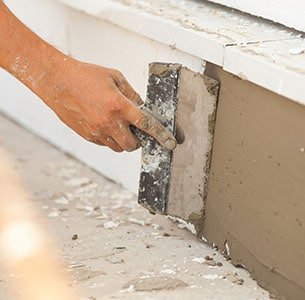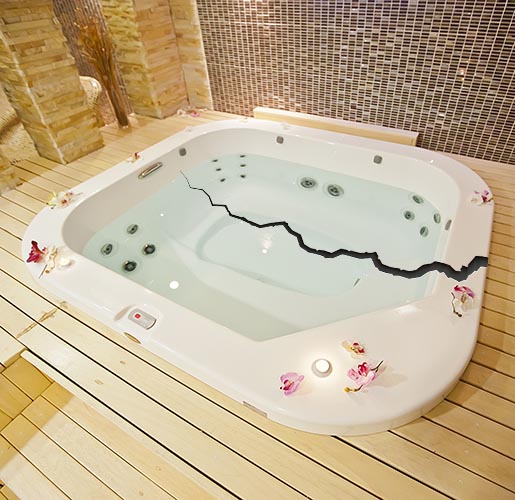Even the smallest cracks and scratches in your hot tub can compromise its safety, comfort and performance. While cracks can cause leaks, scratches can cause discomfort for users and become grooves for collection of debris and bacteria.
Here we’ll discuss what might lead to cracks and scratches on the acrylic surface of your hot tub, and what to do when you want them repaired.
How Do Hot Tub Cracks and Scratches Happen?
Cracks and scratches on the acrylic surface of your hot tub are highly unlikely when proper steps for installation, use and maintenance are observed. Still, certain external factors can cause significant damage.
Improper Surface Beneath the Tub
The hot tub must rest on a level, concrete slab engineered to support the length, width and weight of the filled spa. If the hot tub is not installed and used on such a surface it is extremely vulnerable to damage, including cracks.
Standing Water Deteriorates the Acrylic
The hot tub must be emptied, cleaned and treated according to manufacturer instructions to avoid conditions that could deteriorate and weaken the acrylic. If the acrylic becomes to weak, it will be more likely to scratch and crack.
System Components Aren’t Compatible with the Tub
Only use sanitization, ozone, electrical, mechanical, plumbing and other systems that are approved by the manufacturer. Bringing anything not approved by the manufacturer into contact with the tub has the potential to compromise the surface.
Overexposure to Sunlight
The acrylic shell of the hot tub must not be exposed to sunlight when it’s not in use (whether it’s full or empty). The heat can influence the expansion and contraction of the surface, weakening the surface and increasing the likelihood of cracks. Always keep the tub covered when it’s not in use.
Objects in the Tub
From shoes and toys to dogs and fallen tree branches, anything other than human bodies, swimwear and approved hot tub accessories must stay out of the hot tub. Obviously you can’t control outdoor elements, but keeping your tub covered will minimize what falls in.
Compromised Material and Workmanship
Very rarely, a hot tub will crack or be scratched due to a problem with the materials or workmanship. If this is the case, document the damage and contact the manufacturer immediately to put warranty protections into motion.
Repairing Cracks and Scratches
A hairline scratch isn’t likely to cause much trouble, but most cracks and scratches require immediate attention, before they become bigger problems.
Contact the Manufacturer
For any surface damage that falls under warranty, contact the manufacturer to seek repair or replacement. Be sure to know what’s required of you in terms of making the spa accessible and ordering any parts.
Contact a Local Repair Specialist
Check your local listings and ads for someone who specializes in repairing acrylic hot tub surfaces. Ask what must be done before they come on-site to do the work.
Fix the Scratch or Crack Yourself
This might sound intimidating, but unless you’re dealing with a major crack, you may be able to repair the damage yourself.
Be aware that fixing a scratch or crack yourself may void any surface warranty the manufacturer offers.
 You’ll need some or all of the following:
You’ll need some or all of the following:
- An acrylic repair kit.
- Sandpaper (including high grit).
- Buffer tool for polishing.
- A soft towel.
- A dremmel or other tool for grinding.
- A soldering iron.
Once you’ve emptied, cleaned and dried the tub surface, you’re ready to do the repair itself. Use your soft towel to ensure the area to be repaired is fully cleaned out and free of dry debris.
For a small scratch, simply apply some epoxy from the repair kit, let it dry, and then sand and buff until smooth.
Deep scratches, gouges, burns and cracks require more work. Depending on the damage, you may choose to fill it with epoxy, melt it back together or a combination of both.
Fill with epoxy: The spot to be filled should be V-shaped. You may need to dremmel some acrylic out for this. Fill the space with epoxy from the acrylic repair kit, let it dry and then sand and buff it out until smooth.
Melt the acrylic together: Run the hot soldering iron along a crack to melt together acrylic that has fully separated. You may need to push the iron into the acrylic to get to the bottom of the crack. Sand down any excess acrylic after melting, then follow the steps above for epoxy fill.
If you keep your hot tub long enough, knicks and scratches are likely to happen at some point. Observe all recommended practices to minimize damage, and follow all product instructions if you repair damage yourself to get the most out of your Aqua Living hot tub.



